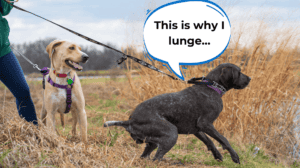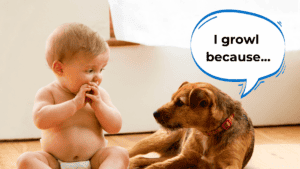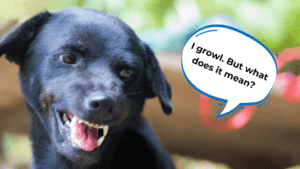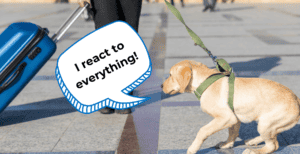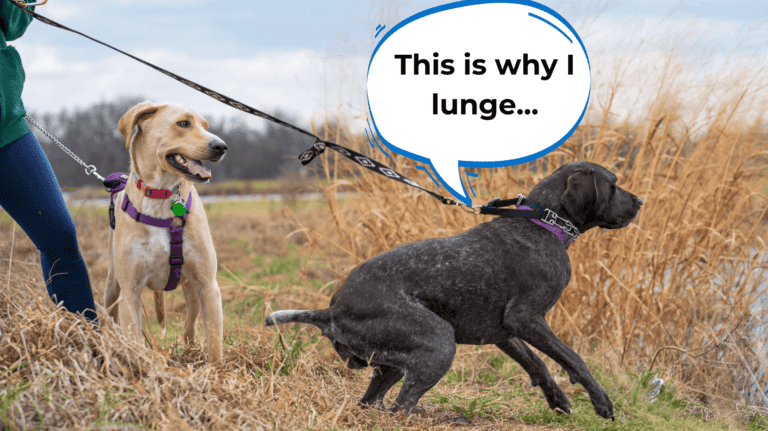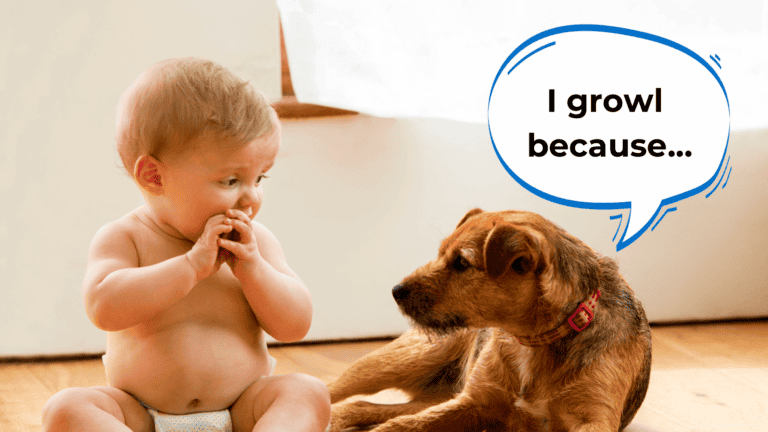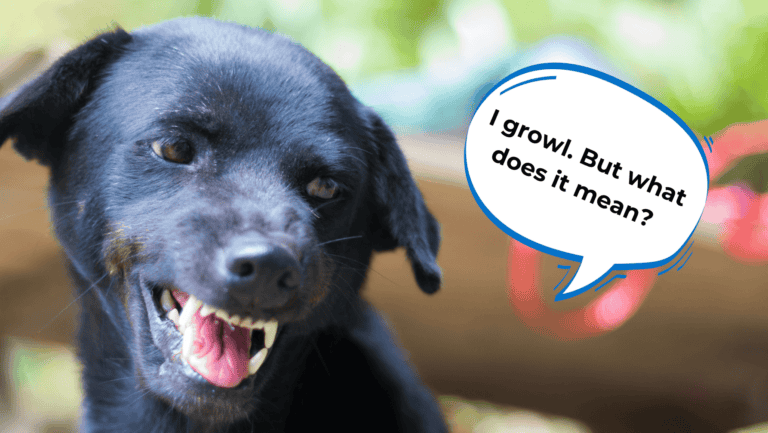A safe space for dogs is synonymous to a human being’s place of refuge — it’s a spot where they retreat from stressors or relax from a long day.
As a dog trainer, I know that our dogs are susceptible to exhaustion, emotional and mental stress, and even anxiety.
Stressors all around them can be too much.

A dog’s safe space is like our pet’s personal space where they can feel truly safe.
Yes, all dogs — no matter the personality and energy levels — can benefit physically, mentally, and emotionally when there’s a safe space for them.
In this blog, I will share why safe spaces for dogs are important, and how you can build one for your beloved pet.
Key Takeaways
- Dogs love sleeping. They need rest to grow and thrive. A safe space can help give a more ideal place for your dog’s rest and retreat.
- Crate is a great option for a safe space, but it’s not the only option. Forts, tents, and even an entire room are effective.
- Safe spaces come with mental, physical, and emotional benefits!
JOIN MY FREE REACTIVITY CLASS
Table of Contents
- Safe Spaces for Dogs: A Dog Trainer’s Perspective
- Why Dogs Need a Safe Space
- Benefits of a Safe Space for Dogs
- What are Examples of The Best Safe Spaces for Dogs?
- When to Put Your Dogs in their Safe Space
- How to Create a Safe Space for Dogs
- Things to Include in Your Safe Space for Dogs
- How to Make a Safe Space Really Feel Safe
- Safe Spaces for Dogs: A Small Change That Creates a Big Difference
Safe Spaces for Dogs: A Dog Trainer’s Perspective
What many people do not realize is that dogs absolutely adore sleeping and resting.
Sleep and rest are vital components of their overall well-being, particularly for young and energetic dogs who are still growing and thriving.
In fact, the connection between sleep and safe spaces for dogs is so strong.
(You can learn more from the video below.)
Just imagine the impact on their physical and mental health if they return from a long, tiring walk only to find themselves stressed, fatigued, or overwhelmed with no dedicated space to retreat to.
Because dogs need refuge, I always encourage dog owners to provide a designated safe space exclusively for dogs.
This special area should solely be reserved for them and off-limits to others so they can recharge, relax, and find solace whenever they need it.
LEARN THE DOG CALMING CODE (FOR FREE)
Why Dogs Need a Safe Space
Because our dogs are perpetually exposed to situations that can cause a sense of unease and vulnerability, a safe space is needed.
Loud noises such as fireworks or thunderstorms can trigger fear in dogs.

Encounters with unfamiliar individuals invading their personal space or entering their home can wire up our pets, making them feel always on the edge.
When the triggers are too much, it is a need that our dogs have a place they can call their safe haven.
“But Doggy Dan, my dog has a crate. Does this mean I should build another safe space for my dog?”
While a crate can serve as a safe space for some dogs, it's not the only option.
The idea behind creating a safe space is to provide a designated area where your dog feels secure and comfortable.
FREE REACTIVITY MASTERCLASS
This space can be a specific room, a cozy corner with their bed and toys, or even a modest area enclosed with a baby gate.

The key is to create an environment that caters to your dog's specific needs and triggers, where they can retreat to when they need a sense of security and calm.
When it comes to a safe space for dogs, this is the general rule: above all, make the room feel as safe as possible.
Benefits of a Safe Space for Dogs
“Should I really make a safe area for my dog?”
I’ve heard this question a thousand times, and I totally get it. Safe spaces for dogs can feel like an extra step… but it’s an extra step worth taking.
A Dog Safe Space Benefits Their Physical Health
From lowering stress levels to giving your dogs a more rejuvenating rest, here are some ways a safe space benefits dogs physically.

Physical Benefit #1: By Removing Potential Hazards and Ensuring a Secure Environment, You Can Prevent Accidents and Injuries
Dogs can be prone to exploring and getting into mischief, so a designated safe space helps minimize the risks they may encounter in your home.
Physical Benefit #2: A Dog-safe Space Allows for Proper Exercise and Play
In addition to protection, our dogs will also have ample room to move around freely, stretch their legs, and engage in physical activities that promote their physical fitness.
With an area exlusively for them, dogs can have more opportunities for play and exercise.
GET MY 5 GOLDEN RULES FOR FREE!
Physical Benefit #3: A Safe Space for Dogs Allows Them to Have a More Rejuvenating Rest
A safe space for dogs goes beyond providing physical security, it also allows them to have a more rejuvenating rest, too!

A designated area where they feel safe and protected, can encourage dogs to fully relax, unwind, and recharge.
This promotes better sleep quality and overall well-being. A peaceful and secure environment in their safe space contributes to a more restorative rest for our pets.
Mental and Emotional Benefits of Safe Spaces for Dogs
Isn’t it such a relief when we have a place to shut off the noise of the world after a long tiring day?
Just like humans, dogs also experience a range of emotions. One moment they are okay, and agitated by overwhelming situations the next.

Having a safe space where they can retreat to when they need solitude and relaxation is essential for their mental and emotional well-being.
A dog-safe space provides a sense of security and comfort. It becomes their own personal sanctuary, away from external stressors or disturbances.
REVERSE REACTIVITY (FREE WEB CLASS)
This safe haven helps reduce anxiety and promotes a sense of calm.
When dogs have a designated space where they feel secure, they can also better cope with changes in their environment or stressful events.
How Safe Spaces for Dogs Help in Owner-Pet Relationship
Because dogs are social animals, they thrive on companionship and a sense of belonging.

With a safe space, you are showing your dog that you understand and respect their needs, which fosters trust and mutual understanding.
Moreover, you can enhance overall well-being, promote a healthier lifestyle, and foster a stronger bond between you and your beloved pet.
Investing time and effort into creating a dog-safe space is a small but significant step towards ensuring their happiness, comfort, and security in your home.
What are Examples of a the Best Safe Spaces for Dogs?
After working with thousands of dogs and pet owners, I have seen thousands of safe spaces that hide dogs from the noise. Below are some ideas for a safe space that always stand out.

Safe Space #1: A Crate
Crates are effective safe spaces for dogs who feel secure in enclosed areas.
Choose a crate that is appropriately sized for your dog, allowing them to stand, turn around, and lie down comfortably.
REACTIVITY SOLVED (NO FOOD, NO FORCE)
Make it cozy by adding a comfortable bed, soft blankets, and some favorite toys. Ensure proper ventilation and place the crate in a quiet area of your home.
Safe Space #2: Rooms
Although crates are a great first choice, choosing a specific room as a safe space also works well for many dogs.
Choose a room with minimal foot traffic and noise, such as a spare bedroom or a quiet corner of your living room.

Create a comfortable environment with a dog bed or soft mat, toys, and water. Use baby gates or closed doors to restrict access and ensure a calm and secure space.
Safe Space #3: Forts or Tents
Building a fort or tent-like structure can provide a cozy and secure den-like space for your dog.

Use blankets, pillows, or even pop-up tents to create a small enclosed area.
Place familiar scents, such as their bed or blankets, inside to make it even more inviting. Make sure the fort is stable and secure to prevent any accidents.
JOIN MY FREE REACTIVITY CLASS
Safe Space #4: Closets or Nooks
Some dogs find solace in small, enclosed spaces like closets or tucked-away nooks.
Clear out a closet or create a cozy corner with a comfortable bed, blankets, and toys. Ensure proper ventilation and keep the area well-lit to maintain a sense of security.
Make sure the space is easily accessible for your dog and free from any potential hazards.
When to Put Your Dogs in their Safe Space
Besides , it’s helpful if you can quickly catch the cues that your dog needs their safe space.
Here are some signs to look out for.
Sign #1: Panting and Drooling
Excessive panting and drooling, even in the absence of physical exertion or heat, can be signs of stress or anxiety in dogs.

If you notice your dog displaying these behaviors, it may be a signal that they need some time in their safe space to relax and find comfort.
Sign #2: Trembling or Shaking
When dogs tremble or shake uncontrollably, it's often a sign of fear or anxiety. This can be triggered by various factors, such as loud noises or unfamiliar situations.
Placing your dog in their safe space can help provide a sense of security and alleviate their trembling.
LEARN THE DOG CALMING CODE (FOR FREE)
Sign #3: Restlessness and Pacing
Dogs may exhibit restlessness by constantly moving around, pacing back and forth, or being unable to settle down.
This behavior indicates that they are uncomfortable or agitated. Introducing them to their safe space can help them find a calm and peaceful environment to relax.

Sign #4: Hiding or Seeking Solitude
Dogs often seek out hiding spots or solitude when they feel anxious or overwhelmed.
If your dog starts retreating to secluded areas of the house or trying to find small spaces to hide in, it's a clear sign that they need a safe space where they can feel secure and protected.
Sign #5: Excessive Barking or Whining
Dogs may resort to excessive barking or whining when they are anxious or stressed.
A dog exhibiting signs of stress through vocalization needs time in their safe space to calm down and regain their composure.
How to Create a Safe Space for Dogs
Whether you’re starting one, or improving the safe space that your dog already has, these tips on creating the best safe spaces for dogs can come in handy.

Tip #1: Find the Best Area for Your Dog’s Safe Space
Evaluate our living environment to determine the best area to designate as your dog's safe space.
A few things to look for: a quiet corner, unused alcove, or a small room that can be repurposed to accommodate your dog's needs.
FREE REACTIVITY MASTERCLASS
Tip #2: Use a Dog Crate
Consider using a dog crate as a safe space, even in limited space.
When choosing a crate for a safe space for dogs, go for an appropriately-sized crate that allows your dog to stand, turn around, and lie down comfortably.
Additionally, you can place it in a quiet area where your dog can retreat and feel secure.
Tip #3: Create a Cozy Nook
Transform a small corner into a cozy nook for your dog.
Use a soft dog bed or blanket to create a comfortable resting area.
Add some toys and a water bowl to complete the space and make it inviting.

Tip #4: Utilize Vertical Space
When horizontal space is limited, make use of vertical space.
Install wall-mounted shelves or floating platforms where your dog can climb or perch. This provides an elevated area for them to relax and observe their surroundings.
Tip #5: Use Pet Gates or Playpens
Set up pet gates or playpens to create a designated safe area for your dog.
These barriers can be used to separate a specific portion of the room or create a small enclosure within a larger space, giving your dog a defined and secure area.
Additionally, a pet gate or pen also comes in handy when you have to separate your pet from other dogs.
GET MY 5 GOLDEN RULES FOR FREE!
Tip #6: Provide Hiding Spots
Dogs often seek out hiding spots when they feel anxious or overwhelmed. Because of this, it’s recommended to consider a spot where they can hide in their safe space.
Create hiding spots by using covered crates, igloo-style beds, or even cardboard boxes with blankets inside. These cozy hiding spots give your dog a sense of security.
Tip #7: Consider Portable Options
If you have limited permanent space, consider portable safe space options.

Portable dog crates, travel tents, or foldable playpens can be easily set up and taken down as needed, providing a safe and familiar space for your dog.
Tip #8: Establish a Routine
Maintain a consistent routine for your dog's safe space.
Designate specific times for your dog to be in their safe space, such as during meal times, quiet hours, or when you're away from home.
Be consistent so that you can help your dog feel secure. Moreover, consistency can establish their safe space as a regular part of their routine.
Things to Include in a Safe Space for Dogs
A safe space for dogs should have everything your pet needs during his quiet retreat. To guarantee that dogs remain safe even while they are away from you, include these essentials to their personal spot.
Safe Space Essentials #1: Comfortable Bed or Mat
Provide a soft and comfortable bed or mat for your dog to rest on. Choose one that is appropriate for their size and offers adequate support for their joints.

Safe Space Essentials #2: Cozy Blankets or Bedding
Place cozy blankets or bedding in the safe space to provide warmth and a sense of comfort for your dog. Ensure they are easily washable for regular cleaning.
Safe Space Essentials #3: Favorite Toys
Include a selection of your dog's favorite toys in their safe space. This helps provide mental stimulation and entertainment, promoting a sense of happiness and relaxation.
Safe Space Essentials #4: Water Bowl
Always provide access to fresh water within the safe space. Use a spill-proof and easily accessible water bowl that is appropriate for your dog's size.
REVERSE REACTIVITY (FREE WEB CLASS)
Safe Space Essentials #5: Chew Toys or Treats
Include appropriate chew toys or treats to help keep your dog occupied and engaged. This can help alleviate boredom and provide a positive outlet for their natural chewing instincts.

Safe Space Essentials #6: Calming Scents
Introduce calming scents in the safe space, such as lavender or chamomile, or which are known to have a soothing effect on dogs. Use CBD oils for dogs and treats specifically formulated to calm pets down.
Safe Space Essentials #7: Familiar Smells
Add items with familiar scents that remind your dog of home, such as a worn t-shirt or a blanket they frequently use. Familiar smells can provide a sense of security and comfort.
Safe Space Essentials #8: Dim Lighting or Blackout Curtains
If your dog is sensitive to light, consider using dim lighting or blackout curtains to create a soothing and peaceful atmosphere within their safe space.
Additionally, consider moving to a spot that isn’t prone to sunlight.
Safe Spaces for Big Dogs Vs Small Dogs: Factors to Consider
Not all safe spaces are created equal… especially for dogs of different sizes. When you’re creating your dog’s safe space, here are a couple of things to consider.
Factor #1: Size of the Space
Big dogs generally require more room to move comfortably compared to smaller dogs.

Their safe space should accommodate their size, allowing them to stand, stretch, and turn around without feeling cramped.
Small dogs, on the other hand, may prefer cozier spaces that make them feel secure.
Factor #2: Durability of Materials
Big dogs may exert more force and have a tendedncy to be more destructive compared to smaller dogs.

It's important to choose durable materials that can withstand their strength and potential chewing habits.
For small dogs, lighter materials may be suitable as they don't exert as much pressure.
Factor #3: Accessibility
Consider the ease of access to the safe space.
Small dogs may need lower entry points or ramps, ensuring they can enter and exit without difficulty.
REACTIVITY SOLVED (NO FOOD, NO FORCE)
Big dogs might require wider entrances or doors that can accommodate their size.
Factor #4: Adequate Support
Big dogs often benefit from additional support in their safe space, such as orthopedic beds or thick padding, to provide proper joint support.

Small dogs may require softer bedding or pillows to ensure their comfort.
Factor #5: Heightened Security Measures
Because of their larger size, big dogs may require sturdier barriers or gates to ensure their safety and containment within their safe space.
Small dogs, on the other hand, may need smaller gaps or closely spaced bars to prevent them from squeezing through.
Factor #6: Noise Reduction
Big dogs may be more affected by noise due to their heightened sensitivity.
Providing soundproofing or using thicker materials for their safe space can help minimize noise disturbances.
Small dogs may be less impacted by noise and may require less soundproofing.
JOIN MY FREE REACTIVITY CLASS
How to Make a Safe Space Really Feel Safe
Dogs are smart — they will run to the safe space once you have established the place as your dog’s safe haven. But how do you do that? I included a few tips below.

Tip #1: Consistency and Routine
Because dogs thrive on routine and predictability, a routine is a must.
Establish a consistent routine for your dog's safe space, including regular feeding times, exercise, and relaxation periods. It’s equally important to follow a predictable schedule to create a sense of security and comfort.
Tip #2: Positive Associations
Associate the safe space with positive experiences for your dog.

As much as possible, refrain from getting angry with your dog while they’re in their safe space. Keep other dogs away, too.
Moreover, associate the safe space with treats, warmth, and soothing silence.
Tip #3: Familiar Scents and Objects
Include familiar scents and objects in the safe space.
Place bedding, blankets, or toys with scents that are familiar to your dog, such as your scent or their favorite toys. These familiar smells provide a sense of familiarity and comfort, so your dogs will feel more at home.
Tip #4: Calming Elements
Incorporate calming elements in the safe space. This could include playing soft, calming music or using white noise machines to mask external noises that may cause anxiety.

Additionally, consider using scents to encourage relaxation.
Tip #5: Adequate Shelter
Ensure that the safe space provides proper shelter from external stimuli.
For example, if your dog is sensitive to noise, choose a location in your home that is away from loud appliances or high-traffic areas.
LEARN THE DOG CALMING CODE (FOR FREE)
Providing a quiet and peaceful environment adds to the overall feeling of safety.
Tip #6: Security and Privacy
Create a sense of security and privacy within the safe space.
Use barriers or curtains to create visual separation from the surrounding environment.
This helps your dog feel protected and reduces the potential for outside disturbances.
Tip #7: Temperature and Ventilation
Maintain a comfortable temperature and good ventilation in the safe space. Check for proper airflow and regulate the temperature to keep your dog comfortable.

Because extreme temperatures can cause stress and discomfort, it’s crucial to monitor the conditions within the space accordingly.
Tip #8: Respect Boundaries
Respect your dog's boundaries within their safe space.
Allow them to come and go as they please, and avoid disturbing them when they seek solace in their designated area.
Respecting their boundaries reinforces the feeling of safety and trust because it tells your dogs “I respect your feelings.”
GET THE DOG CALMING CODE™️
Safe Spaces for Dogs: A Small Change That Creates a Big Difference
Investing in a safe space is also a small gesture that yields immeasurable benefits for our beloved canine companions.
It’s like telling your dog: “I understand how stressful it can be. I know you need this.”
Your dog’s safe space — their very own — can bring tremendous change on how they rest, how they relax, and how they regulate stressors and emotions.
If you’re ready to go to great lengths for your dog’s health and overall happiness, start with a safe space.

~ Doggy Dan




